|
|
|
Sort Order |
|
|
|
Items / Page
|
|
|
|
|
|
|
| Srl | Item |
| 1 |
ID:
120205
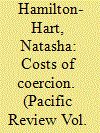

|
|
|
|
|
| Publication |
2013.
|
| Summary/Abstract |
Violent conflict tends to be costly overall, but can, under some conditions, yield net gains for the initiators of violence, thus creating incentives for coercion. This article explores the economic incentives for coercion across three different arenas and types of conflict: international conflict among states, organized political violence within the state, and relatively unorganized domestic conflicts over property rights. Although these conflicts are normally studied in separate scholarly traditions (respectively, international relations, domestic security studies and political economy), drawing from these different traditions can help explain the comparative incidence of coercive force in different conflict arenas by identifying conditions that create incentives for violence. Using cases from Southeast Asia, the article offers an explanation for the empirical pattern of violence in the region being more prevalent currently at the domestic, rather than the international, level and most pervasive in apparently low-level and unorganized forms. At least in part, this pattern is a consequence of the relative stability and consistent protection of what may be thought of as international property rights claims, compared with the greater uncertainty and inconsistency in the enforcement of domestic rights claims. While intuitively paradoxical when viewed through Westphalian lenses, which assume international anarchy and domestic hierarchy, greater contention over domestic rights claims is consistent with the relative asymmetries in coercive capabilities and institutions for dealing with rights claims at the domestic level, compared with the international arena.
|
|
|
|
|
|
|
|
|
|
|
|
|
|
|
|
| 2 |
ID:
120203
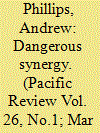

|
|
|
|
|
| Publication |
2013.
|
| Summary/Abstract |
This paper analyzes the current and prospective implications of Asia's energy consumption revolution for regional stability. Adopting a comparative and historical approach, I argue that Japanese energy security anxieties worked to reinforce regional alignment patterns in East Asia for nearly two decades following the Shanghai communiqué, thereby strengthening regional stability. Conversely, the post-Cold War period has seen in China and India's rise the emergence of Asian energy super-consumers that are not formally aligned with the United States, but that are increasingly dependent on imported energy supplies to fuel their industrialization. This newfound dependence on energy imports has seen both countries follow Japan's longstanding example in securitizing energy as a policy issue. In the context of an already more contested Asia, this trend towards energy securitization has aggravated regional tensions and will continue to do so unless greater efforts are undertaken bilaterally, regionally and globally to foster more effective forms of energy cooperation.
|
|
|
|
|
|
|
|
|
|
|
|
|
|
|
|
| 3 |
ID:
120202
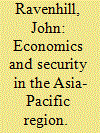

|
|
|
|
|
| Publication |
2013.
|
| Summary/Abstract |
The relationship between economics and security remains relatively unexplored, particularly in the Asia-Pacific context. The articles in this special section of the journal seek to broaden our comprehension of various dimensions of this relationship. One focus is to understand the circumstances in which issues have come to be defined as components of national 'security'. A second is to develop a more nuanced approach to conflict, one that recognizes that interstate conflict can take numerous forms short of the outbreak of military confrontation. Our starting point is to emphasize that 'security' is a social construction: issues become 'securitized' when political actors identify them as posing a threat to national security. The redefinition of national understandings of security by state elites is one instance of how economics and security can become intertwined. Economic competition, however, can generate a second dimension to the economics-security nexus, which occurs when it spills over into the traditional security domain, that is, into military rivalries between states. Our studies provide some grounds for optimism on the relationship between economics and security - albeit one that has to be tempered both by the failure of countries in the region to develop deeply institutionalized means for dispute resolution and by the evidence that economic issues can be a significant source of both interstate and intrastate conflict.
|
|
|
|
|
|
|
|
|
|
|
|
|
|
|
|
| 4 |
ID:
120206
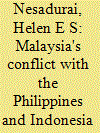

|
|
|
|
|
| Publication |
2013.
|
| Summary/Abstract |
If labour migration increases the potential for interstate conflicts, does the economic interdependence thus created make such conflicts easier to address, given the economic gains to both sides from such labour movements? This article addresses this question by using the concepts of economic security and interdependence to compare the Malaysia-Philippines and Malaysia-Indonesia conflicts over labour migration. Although the limited cases make generalizations difficult, the analysis suggests that the economic interdependence constraint on conflict escalation may not always work well as it may be offset by national security concerns in the labour receiving states about the illegal migrant workers and by the shifting economic underpinnings of economic security. The theoretically pacifying effect of interdependence can also be weakened by preventing the 'aggrieved country' from articulating clearer demands from the other side for fear of jeopardizing the economic gains from the migrant outflows. Comparing the two conflicts suggests that clearly articulated demands matched by effective state capacity in translating those demands into actions on the ground can help in conflict management. The potential for the migrant worker issue to evoke deep emotions and the ease with which that can translate into nationalist outpourings mean that both sending and receiving countries must develop bilateral or regional frameworks that outline clear best practice standards for the treatment of migrant workers, including during detention and repatriation.
|
|
|
|
|
|
|
|
|
|
|
|
|
|
|
|
| 5 |
ID:
120204
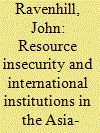

|
|
|
|
|
| Publication |
2013.
|
| Summary/Abstract |
East Asian governments have long recognized that national security must incorporate a reduction of their vulnerability to the disruption of essential imports. The rapid economic growth of China and India has intensified competition for increasingly scarce resources, elevating resource security once again to the top of the international agenda. Issues that were previously regarded as 'technical' have been 'securitized' as state elites perceived possible conflicts over availability and pricing of natural resources as threats to national security.
International institutions have the potential to contribute to the defusing of tensions over the supply of commodities by providing, through various means, assurances regarding the behaviour of partners. Only the global institutions concerned with commodities trade, the International Energy Agency (IEA) and the World Trade Organization (WTO), have legally binding arrangements and the authority to impose sanctions on states that fail to comply with their obligations. But both have weaknesses: the IEA's membership is limited; the WTO's rules relating to raw materials trade are far from comprehensive. Most of the regional institutions in this field seldom go beyond information exchange or the setting of aspirational targets. At the bilateral level, government attempts to enhance resource security through minerals chapters in preferential trade agreements have had little success. Bilateral investment treaties are the only instances of cooperation at the sub-global level that incorporate legally-binding provisions.
The cooperation on resources issues in which countries have engaged has reflected the core characteristics of Asia-Pacific bilateral and regional intergovernmental institutions. The shallowness of cooperation reflects perceptions on the part of state elites that their interests in the resources sector are best served by national rather than collective action and that current cooperative arrangements fail to provide sufficient incentives to prevent states from succumbing to opportunistic behaviour in the event of a short-term clash of interests. The potential gains to be made from a cooperative approach to resource security remain largely unrealized.
|
|
|
|
|
|
|
|
|
|
|
|
|
|
|
|
|
|
|
|
|